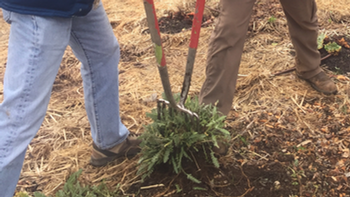News from the Edible Demo Garden
January 2021: Propagation

What is Propagation?
Propagation is the process of creating new plants. Most of the plants in our garden are created by sexual propagation in which the pollen (male) of a plant combines with the egg (female) resulting in a seed. But new plants can also be created by asexual methods. A simple example is rooting a plant part in water. Another asexual method is propagation by division. This type of propagation is used on plants that have stolons (aka runners), bulbs, tubers, or rhizomes. These plants produce multiple stems above the ground. A plant with a single stem cannot be propagated by division.
Techniques for Propagation by Division
We have many perennial plants in our garden that were planted to attract pollinators. One of these plants is yarrow. It is a beautiful plant that produces lemon yellow flowers in the spring and summer. We now have two of them and it was time to create some more for another part of the garden.
These were the steps we took to divide it:
- scraped back the soil and debris under the plant
- determined a place where the plant looked like it would naturally separate
- used the Double-fork Method* for separating the new plant from the mother plant
- with a shovel, made 2-3 cuts around the new plant to release it from the soil and mother plant
- removed the new plant from the ground with a shovel
- planted the new plant in another part of the garden mixing in some compost with the soil in the planting hole
- watered well
*Double-fork method
Insert a spading fork into the ground where you want to make the division with the back of the fork positioned away from you. Have a garden buddy do the same thing from the other side of the plant so that the forks are back to back and the tines are interlocked. First, you and your buddy push the forks toward each other and then pull them away.
Other Plants Requiring Division
Some of our rhubarb plants that have been in the ground for a long time will need dividing also this winter in addition to some herbs like chives that would benefit from more space.
This is the time of year when the soil is moist to look around your garden and give yourself the gift of new plants that you can use to extend your garden or just to fill in some spaces. Jump right in and propagate!
